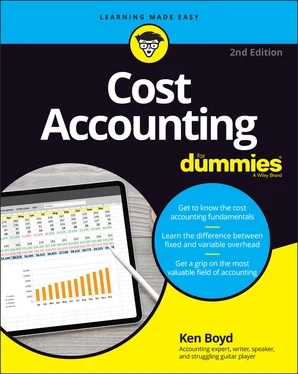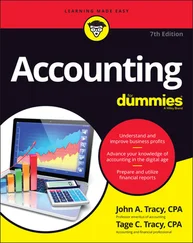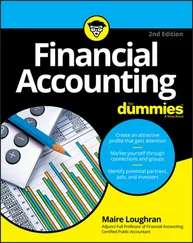Kenneth W. Boyd - Cost Accounting For Dummies
Здесь есть возможность читать онлайн «Kenneth W. Boyd - Cost Accounting For Dummies» — ознакомительный отрывок электронной книги совершенно бесплатно, а после прочтения отрывка купить полную версию. В некоторых случаях можно слушать аудио, скачать через торрент в формате fb2 и присутствует краткое содержание. Жанр: unrecognised, на английском языке. Описание произведения, (предисловие) а так же отзывы посетителей доступны на портале библиотеки ЛибКат.
- Название:Cost Accounting For Dummies
- Автор:
- Жанр:
- Год:неизвестен
- ISBN:нет данных
- Рейтинг книги:4 / 5. Голосов: 1
-
Избранное:Добавить в избранное
- Отзывы:
-
Ваша оценка:
- 80
- 1
- 2
- 3
- 4
- 5
Cost Accounting For Dummies: краткое содержание, описание и аннотация
Предлагаем к чтению аннотацию, описание, краткое содержание или предисловие (зависит от того, что написал сам автор книги «Cost Accounting For Dummies»). Если вы не нашли необходимую информацию о книге — напишите в комментариях, мы постараемся отыскать её.
Cost Accounting For Dummies
Cost Accounting For Dummies
Cost Accounting For Dummies — читать онлайн ознакомительный отрывок
Ниже представлен текст книги, разбитый по страницам. Система сохранения места последней прочитанной страницы, позволяет с удобством читать онлайн бесплатно книгу «Cost Accounting For Dummies», без необходимости каждый раз заново искать на чём Вы остановились. Поставьте закладку, и сможете в любой момент перейти на страницу, на которой закончили чтение.
Интервал:
Закладка:
You incur some costs to do the analysis. Someone on your staff will go through the employee time cards (used for payroll). The workers record the time they spend on all tasks, including sanding. They also record the table models they worked on during production. Your accountant can compute the total sanding time per table model, based on the time cards.
Consider what you might gain. You assign the sanding cost more precisely. As a result, each table model’s total cost is more accurate. Because your profit is the sale price less the total costs, the updated cost allows you to calculate a more precise profit. Sounds like the cost of the analysis might be worth it, especially if the competition is high in your furniture-making industry.
Planning your work: Budgeting
Cost accounting plays a role in your budgeting process. You might think of budgeting as just forecasting sales and planning expenses. If you own a flower shop, you budget by forecasting sales of each type of flower or arrangement. You also plan expenses, such as utility costs for the shop and your lease payment.
Your work with cost accounting takes budgeting to a new level of detail. Until now, you looked at costs by type (utilities, lease expense). Now, you analyze cost by type and by product (for example, those roses need to be kept in a cooler, which requires electricity). Based on the product’s costs and sale price, you can compute a profit.
So start off with an analysis of each product’s cost, price, and profit. Build on that information. You could then put together a budget for each department. Finish up by combining all your smaller budgets into a company-wide budget. That company-wide budget will give you all the company’s costs by type and your revenue total. You build your company-wide budget based on cost accounting by product.
By starting your budget at the product level, your budget is a lot more specific. When you compare your actual results to your budget, you’ll see the differences in more detail. The detail lets you make more precise changes in your business going forward.
Controlling your costs
Cost accounting helps you stay on top of your costs — and make changes along the way. You should analyze costs frequently. Most companies perform this analysis on at least a monthly basis … and sometimes weekly or even daily. The more specific you make your analysis, the better. As always, the benefits you gain from your analysis should outweigh the costs.
If you analyze costs frequently, you find areas where you can reduce costs immediately. There’s nothing worse than discovering a problem after it’s too late to fix, so don’t create a budget and shove it in a drawer. Review your actual results, and compare those results to your budget. If you find large differences, dig deeper. Consider reviewing more detail to find out what caused the difference.
Here are some tools you can use to control costs. Each tool is explained in detail in this book:
Cost-volume profit (CVP) analysis: CVP is a simple tool to analyze costs, sale price, and units sold. There’s a user-friendly formula — the kind of tool you can play around with on a notepad or spreadsheet. Check out Chapter 3for more on CVP.
Variance analysis: A variance is the difference between your planned costs and actual costs. A large variance is a red flag — a number that gets your attention. You investigate variances to find ways to reduce your costs. Chapter 7tells you more.
Activity-based costing (ABC): This analysis allows you to assign costs using the activities put into making your product or service. ABC assigns costs to products based on levels of activity: labor hours incurred, machine hours used, and so forth. See Chapter 5for an in-depth look.
Support costs: Nearly every business incurs support costs. These are areas of your business that support your production and sales efforts. Accounting and legal costs are good examples of support costs.
Joint costing: Your business may use the same process to produce several different products. This situation is called joint production. The products will share common costs of this production, or joint costs. Now, it’s likely that each product has its own unique costs after joint production; however, you need a tool to allocate the joint costs when the products are produced together.
Setting a price
After you’ve nailed down your product’s full cost (all costs, both fixed and variable), you can price your product effectively. The difference between your price and full product cost is your profit (see Chapter 12).
Pricing and competition
Consider how pricing comes into play. Your product’s price may be limited, based on competition. Say you sell baseball gloves. To compete and maintain your current level of sales, you can’t price your glove any higher than $100.
To meet your profit goal, you start at the top and work your way down. The top is your $100 price; you can’t go any higher without losing sales. Your profit is sale price less cost. The only way to increase your profit is to lower your costs.
Increasing a price
Assume that you make a product that’s unique. You don’t have many competitors. As a result, customers are willing to pay more because they can’t get the same product somewhere else.
To meet your profit goal, you start at the bottom and work your way up. You compute your full costs first. Then you calculate a sale price, based on your profit goal. You have the ability to push the top (the price) higher because you believe that customers are willing to pay a higher price.
Changing prices after more analysis
In the section “ Controlling your costs,” you see a list of tools to analyze costs. You use the tools to assign costs to your products more precisely. When you change the costs assigned, you can consider changing the product’s price. That’s because a change in the product’s cost changes the level of profit.
For an example, let’s say that you sell hiking boots. In planning, you budget a sale price of $80 per pair. During the year, you start performing cost analysis. You determine that $5 more in machine production cost should be assigned to each pair of hiking boots.
That $5 increase in cost lowers your profit. So you have a few choices to make to maintain the same level of profit. You could decide to raise your price. If you face heavy competition, a higher price may hurt your sales. The other choice is to find ways to lower other costs.
Keep in mind that pricing your product isn’t a one-time event. As you analyze costs, you may need to adjust prices more than once during the year.
Improving going forward
Successful businesses constantly make improvements. This approach is the only way companies can survive and thrive over the long term. That’s because competitors eventually take business away from you if you’re not willing to change.
One type of improvement is analyzing your business to lower costs. You can lower your costs in several ways. Maybe you remove an activity that isn’t necessary. When you eliminate the activity, you get rid of the related costs. Here are some other possible improvements.
Using the accrual method of accounting
You decide to use the accrual method of accounting. This method matches your revenue with the expenses you incur to generate the revenue. Using this method, rather than the cash basis of accounting, gives you a more realistic picture of your profitability.
 The cash basis posts revenue and expenses based on cash inflows and outflows, which distorts the true profitability of your business. Using accrual accounting helps you make more informed decisions.
The cash basis posts revenue and expenses based on cash inflows and outflows, which distorts the true profitability of your business. Using accrual accounting helps you make more informed decisions.
Интервал:
Закладка:
Похожие книги на «Cost Accounting For Dummies»
Представляем Вашему вниманию похожие книги на «Cost Accounting For Dummies» списком для выбора. Мы отобрали схожую по названию и смыслу литературу в надежде предоставить читателям больше вариантов отыскать новые, интересные, ещё непрочитанные произведения.
Обсуждение, отзывы о книге «Cost Accounting For Dummies» и просто собственные мнения читателей. Оставьте ваши комментарии, напишите, что Вы думаете о произведении, его смысле или главных героях. Укажите что конкретно понравилось, а что нет, и почему Вы так считаете.












